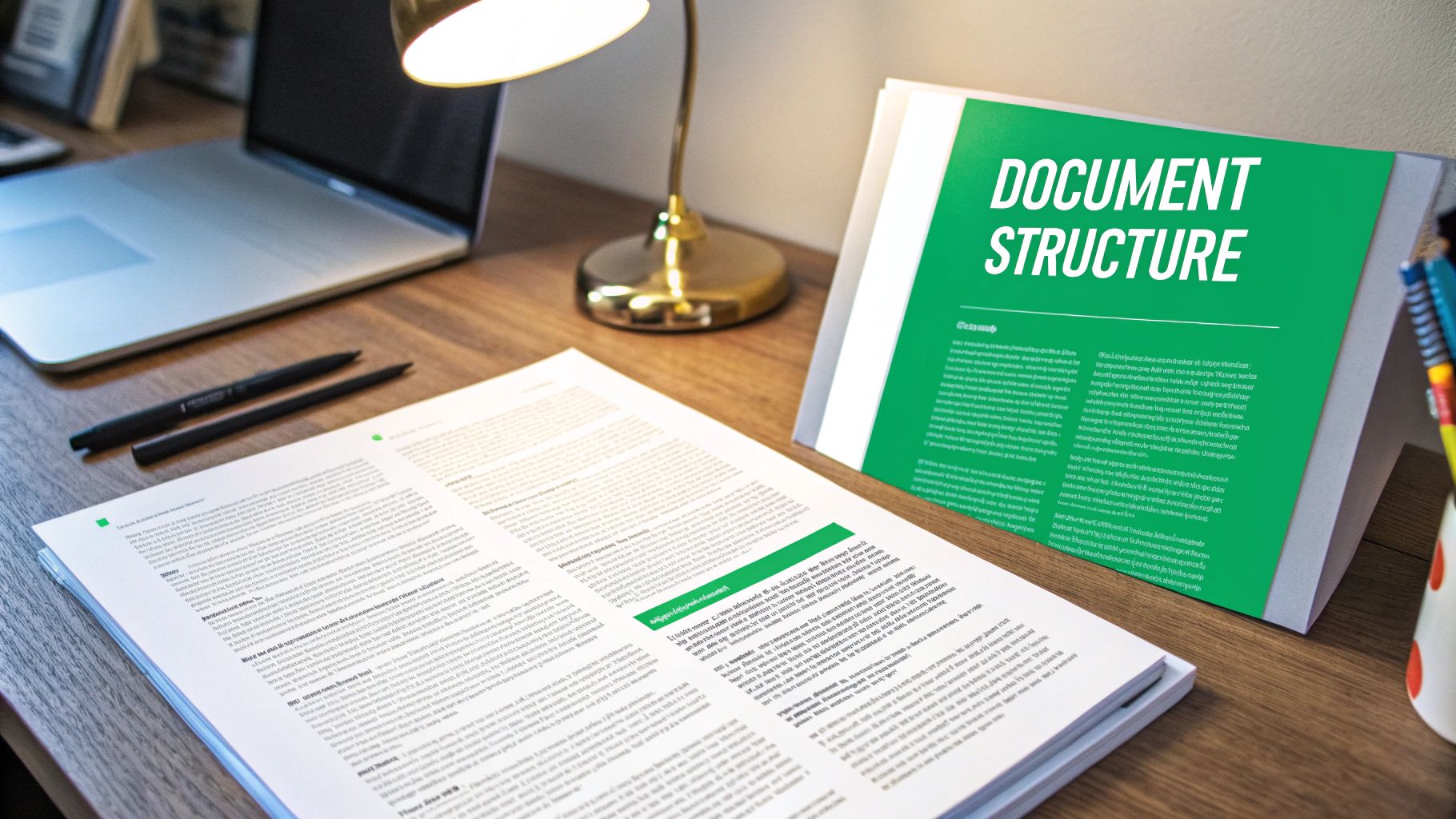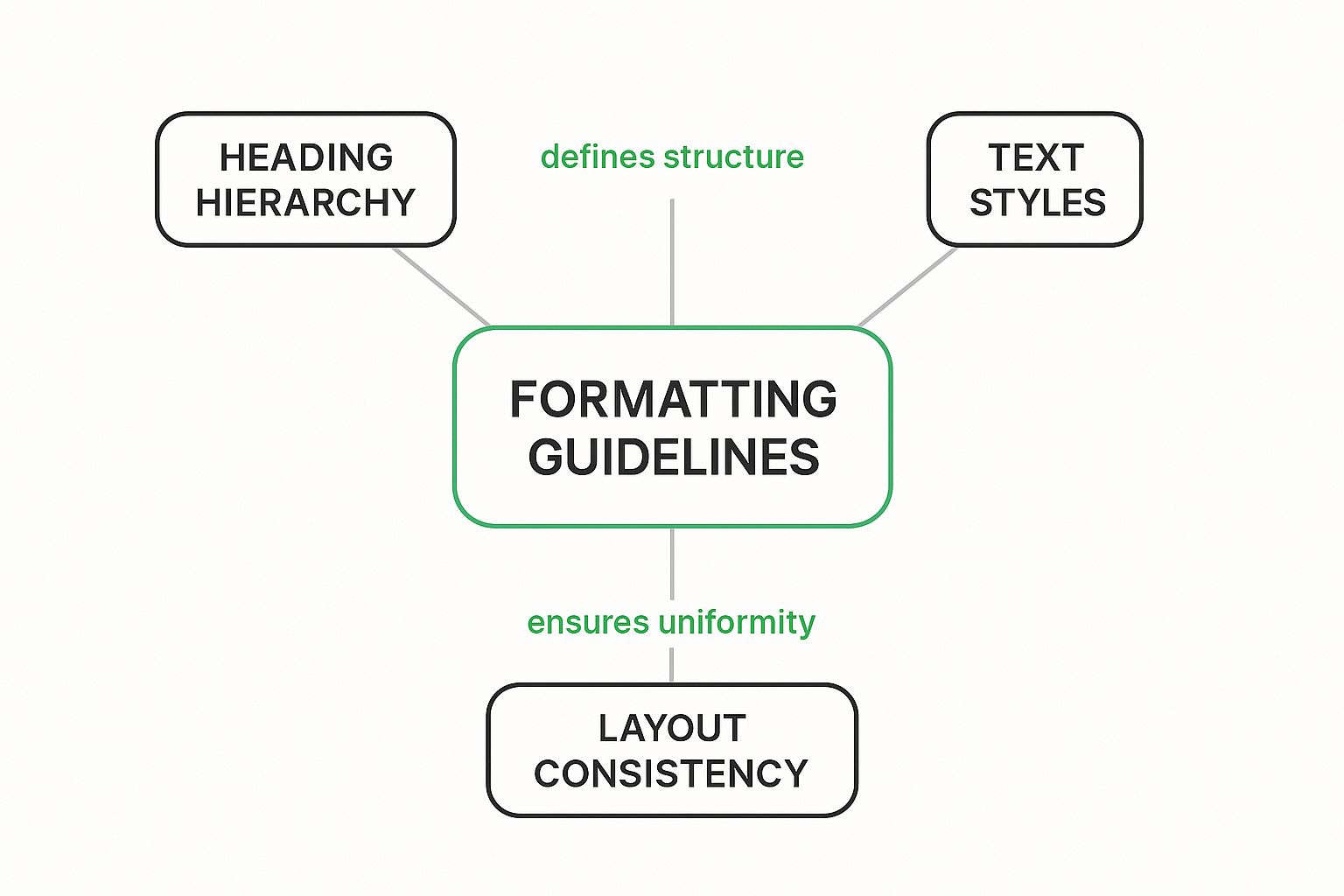Build effective help content with our technical documentation template. Get expert guidance, examples, and a proven structure for clarity and consistency.
Think of a technical documentation template as a pre-built blueprint for creating clear and useful content. It’s a standardized framework that gives you a repeatable structure for everything from user guides to complex API references. Instead of staring at a blank screen every single time, your team has a solid foundation to build upon.

Let’s be honest, that blinking cursor on an empty page is where good intentions go to die. It’s also the fastest way to end up with inconsistent, confusing, and ultimately unhelpful documentation. A solid template is your best defense, shifting your team from writing chaotic, one-off documents to building a structured system that actually scales.
When you have a template, you’re establishing a baseline for quality. It ensures every piece of content—no matter who writes it—meets a specific standard. It completely gets rid of those inefficient “blank-page starts” that burn through valuable engineering and writing time. We’ve seen companies that adopt templates dramatically improve how scalable and maintainable their documentation becomes over time.
Having a standardized approach really pays off. It brings a few core benefits that you’ll feel almost immediately. A good template is more than just a document; it’s a strategic tool for truly mastering your software technical documentation.
A standardized template offers a powerful set of advantages that directly influence efficiency, user satisfaction, and operational costs. Here’s a quick breakdown of how implementing one can impact your business.
Ultimately, implementing a template isn’t just about making things look nice—it’s about improving the user experience, managing long-term operational costs, and creating a more efficient workflow for everyone involved.

A really solid technical documentation template isn’t just a collection of random sections. It’s built on a few core components that you just can’t skip. Think of them as the architectural pillars holding everything up—they provide structure, credibility, and clarity right from the get-go.
The first piece of the puzzle is a clean Title Page. This is your document’s identity card, spelling out the product or feature name, the version, and when it was published. Right after that, an auto-generating Table of Contents is absolutely essential. It lets people jump straight to the info they need without scrolling endlessly.
The introduction is where you set the stage. Its job is simple: quickly explain what the document covers, who it’s for, and what they’ll get out of it. A good intro manages expectations and helps readers decide instantly if they’re in the right place.
Just as critical is the Version History, or changelog. This is all about building trust. By keeping a detailed log of every update, fix, and change, you’re being transparent with your users.
As you’re putting these essential pieces together, don’t forget the importance of creating a robust business writing style guide. This is what ensures your tone, voice, and terminology stay consistent from one document to the next. It’s that harmony between structure and style that separates adequate documentation from truly exceptional work.

The core sections are the real meat of your technical documentation template. This is where your users are digging for the critical info they need to get their job done. How you organize this content makes all the difference—a scattered, illogical layout just creates frustrated users, but a thoughtful structure empowers them to find answers fast.
Your template needs to account for different kinds of content because each one serves a very different purpose. You wouldn’t format a tutorial the same way you’d format a technical reference, right? It just wouldn’t make sense.
This is why your main template should have specific sub-templates or, at the very least, crystal-clear guidelines for the most common content your team will be creating.
The trick is to match the format to the function. A “Getting Started” guide, for instance, is all about action. It needs to walk a brand-new user through their first successful run-in with your product. An “API Reference,” on the other hand, is basically a dictionary; its job is to be precise and let people look things up quickly, not to tell a story.
Let’s break down how you might structure these common sections in a practical way:
Let’s be honest: a technically perfect document is completely useless if nobody can find the information they need. A well-designed technical documentation template is what separates a simple text file from a genuinely helpful user resource. The key is prioritizing discoverability and ease of use. This means building a smart navigational structure that anticipates what users are looking for and gets them answers fast.
The foundation of this structure relies on a few key navigational aids. When you implement these tools, you empower people to explore complex topics, see how different concepts are related, and get around your knowledge base without getting frustrated. The goal is a supportive, seamless experience, not a dead-end document.
The best documentation feels like a guided tour, not a maze. To make sure every document is a breeze to navigate, your template should have dedicated spots for these critical components.
This concept map really drives home how central good formatting guidelines are to creating a usable document.

As the visual shows, things like heading hierarchy, consistent text styles, and a predictable layout are the pillars of clear formatting. By standardizing these elements in your template from the get-go, you guarantee that every document is instantly scannable and feels familiar to the reader. That alone will dramatically improve its usability.
Let’s face it: text alone just doesn’t cut it anymore. Today’s users expect rich, engaging content, and any technical documentation template worth its salt needs to deliver on that. We’re not talking about adding multimedia just for show—it’s a smart way to help people understand complex topics and avoid information overload.
This means being strategic about when to use things like annotated screenshots, architectural diagrams, or quick video tutorials to make difficult steps clearer. For example, a step-by-step installation guide becomes infinitely more helpful with short video clips. On the other hand, an architectural overview really needs a clear, interactive diagram to land properly. Your template should have dedicated spots and guidelines for these elements to keep everything consistent. For a deeper look at matching content formats to user needs, check out our comprehensive guide on technical documentation types.
Beyond media, responsive design is completely non-negotiable. With a staggering 99.5% of field technicians using mobile devices on the job, your documentation has to look good and work perfectly on any screen, from a huge monitor down to a smartphone.
A responsive template automatically adjusts your content so it’s always usable, which means no more frustrating pinching and zooming for your readers. You can get a better sense of how mobile access is shaping the industry by exploring current technical documentation trends.
So you’ve built out a brilliant technical documentation template. That’s great, but it’s only half the battle. If you’re not tracking its performance, you’re just guessing about its impact. You have to treat your documentation like any other product, and that means measuring its success.
Without solid metrics, you’re flying blind. These days, tracking key performance indicators (KPIs) is standard practice for figuring out what’s working and what isn’t. Teams look at everything from how often the docs are used to how easy they are to find. The goal is to improve the self-service experience, which ultimately leads to lower support costs and happier users.
To get a real sense of your documentation’s health, you don’t need a thousand different metrics. Just focus on a few core ones that give you actionable insights, not just vanity numbers.
By digging into these numbers, you can spot weak points in your content, make a strong case for more resources, and actually demonstrate the value your documentation brings to the table. And of course, nailing the fundamental technical documentation requirements is the first step to hitting these performance goals in the first place.
Of course, even with a solid template in your hands, you’re bound to have some questions. Building a new documentation system always surfaces a few things. Let’s tackle some of the most common questions we hear about creating and using a technical documentation template so you can sidestep the usual hang-ups.
Think of your template as the blueprint for all your content. Its real power, though, comes from how well your team understands it and actually uses it. Let’s clear up a few key points.
Every part of a template has its job, but if you have to pick just one thing, it’s consistency. Hands down. When your structure, tone, and formatting are the same across every document, users know exactly where to find what they need, every single time. That predictability is huge—it builds trust and cuts down on the mental effort needed to find an answer.
When people aren’t struggling to figure out your layout, they can focus on what really matters: understanding the information. This is a game-changer, especially for really dense or complex topics. It just makes the whole experience better.
Your template should never be a “set it and forget it” kind of thing. Treat it like a living document. You should plan on giving it a thorough review at least once a year, or sooner if there’s a major product update, a rebrand, or a switch in the tools you use.
You really don’t have to choose. A hybrid approach almost always works best. Start by creating one master technical documentation template that locks in the essentials—the stuff that should never change, like your branding, voice and tone guidelines, legal disclaimers, and how you handle versioning. Once you have that solid foundation, you can build out different versions for specific needs.
For instance, you’ll want different flavors of your master template for:
This way, you get the best of both worlds. You maintain a consistent feel across all your documentation while still tailoring the layout for what each type of content actually requires. The end result is a much better, more intuitive experience for your users.
Ready to stop writing documentation from scratch and start building a scalable knowledge base? DocuWriter.ai uses AI to generate clear, consistent, and accurate documentation in minutes. Explore our features and start your free trial today.